
Railway Street Presbyterian Church
|
|
|
Railway Street Presbyterian Church, opened in March 1864. |
|
|
|
|
| Rev. Brian Gibson
Minister |
The Very Rev. Dr. Howard Cromie Minister Emeritus |
Rev. Bob Lockhart
Pastoral Minister |
 |
|
Andrew Masters Co-ordinator of Youth and Family Work |
Railway Street, Lisburn.
Minister: Rev. Brian Gibson
Telephone: 9266 2149
Minister Emeritus: The Very Rev. Dr. Howard Cromie
Pastoral Minister: Rev. Bob Lockhart
Co-ordinator of Youth and Family Work: Andrew Masters
Sunday services:
Morning Service: 10.30am
Evening Service: 6.30pm
During July and August the congregation joins with some neighbouring churches
for Summer Epilogue Services at 8.00pm.
Church Website: Railway Street Presbyterian Church
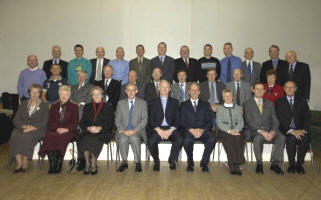
Kirk Session
L to R: (front) Edith McConnell, Heather Henry, Gladys Brown, Gordon Lindsay - Clerk of Session, Rev. Brian Gibson- Minister, Maurice Gowdy - Treasurer, Sadie Meban, Freddie Hall and David Kime. (second row) Geoffrey Baird, George Toombs, Stuart Cameron, Norman McClelland, Billy Tease, Ian Barron, David Artt, Eric Scott and Margaret Coulter. (back row) Euan McConaghie, Kenneth Kyle, Aaron Curragh, Don Mitchell, Ian Wales, John Martin, Sam Mitchell, Billy Bittle, Bryan Nelson, Ian Menown, Brian Patterson, Roger Thompson and Len Murray. Missing from the photo: Annesley Anderson, Norma Coggins, Myrtle Henderson, Tim Mitchell, John McBurney, Harold Patterson, Ron Thomson and Vivienne Weir.
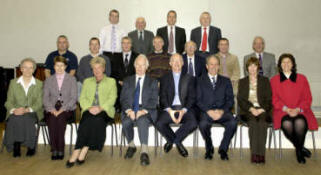
Congregational Committee
L to R: (front row) Bertha Cowan, Elizabeth Bridgett, Elizabeth Menown, Robin Coulter - Secretary, Rev. Brian Gibson - Minister, Maurice Gowdy-Treasurer, Jean Murray and Janet Ferguson. (second row) Craig Adair, Geoffrey Reid, Ivan Woods, Geoffrey Rogers, Billy Braithwaite, Gordon Crawford and Colin McLean. (back row) David Milligan, Raymond Spence, Ian Mulholland and John Kelly. Missing from the photo: Nigel Brown, Karen Elliott, John Gillespie, Robin Martin, William McClelland, Grace McCombe, Pamela Russell and Gordon Wallace.
Railway Street's Ministers Past and Present
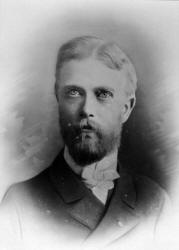 |
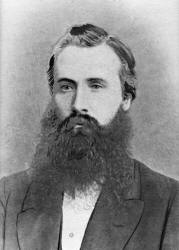 |
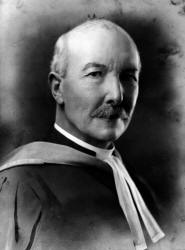 |
| The first minister Rev David John Clarke 1861 – 1878 |
The second minister Rev James Lyle Bigger 1879 – 1885 |
The third minister Rev Robert Wilson Hamilton 1885 – 1935 |
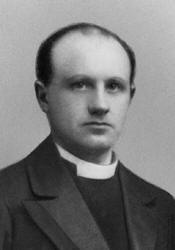 |
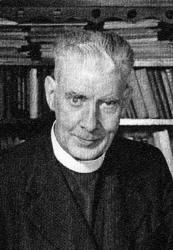 |
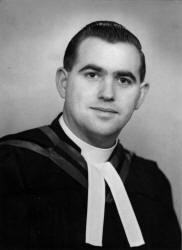 |
| The fourth minister Rev. Thomas Henry
Robinson 1930 – 1938 |
The fifth minister Rev John Knox Elliott 1939 – 1961 |
The sixth minister Rev Howard Cromie 1962 – 1993 |
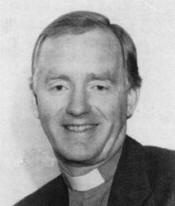 |
||
| Seventh and present minister Rev Brian Gibson 1994 - present |
||
HISTORY
The Revival of 1859, coupled with the growth of Lisburn through expanding industries, resulted in the Presbyterian Church building in Market Square (1stLisburn) being inadequate to accommodate the numbers attending public worship. In 1860 Wm. Barbour, founder of the linen firm that bears his name, and an elder in the Church, encouraged the formation of a new congregation in the town.
The General Assembly approved the organization of such a congregation, and in 1860 the Rev. John Powell, a minister without charge from the South of Ireland, who was also conducting a classical school in the town, held services in a hay loft in Castle Street, granted by Mr. Jonathan Richardson of Killeaton. The first committee of the new congregation was elected in November 1860.
In 1861 the majority of the congregation, faced with the calling of a minister, favored Mr. David John Clarke (lic. Down). On the latter being called Mr. Powell applied to the Original Secession Synod and founded the congregation now known as Sloan Street. The Rev. D. J. Clarke continued to minister in Castle Street until the new Church was opened in Railway Street on Sunday 6th March 1864. During Mr. Clarke’s ministry, the Railway Street National Schools at the rear of the church were built in 1869. Also at that time, a manse beside the church and an adjoining house (now 31 and 33 Railway Street) were built. After an exacting and effective ministry Mr. Clarke died on 23rd November 1878 at the age of 44 years.
The second minister of the congregation, Mr. James Lyle Bigger (lic. Derry) was a distinguished scholar. He was ordained on the 16th October 1879 and was appointed Professor of Hebrew and Biblical Criticism in Magee College, Londonderry, in 1885, and resigned Lisburn on 17th July 1885. Professor Bigger’s successor was Rev. Robert Wilson Hamilton of Burt, Co. Donegal. He was later to be an outstanding figure in the General Assembly, becoming Moderator in 1924. Installed here on 8th October 1885, he was a most energetic pastor, keenly evangelistic and yet with warm and broad sympathies. During his ministry, a new Lecture Hall was built in 1887. Side galleries were added in the church in 1897 and a new organ in 1908. A new manse was built at Fort Hill in 1900, the E.M.B. hall at Hilden in 1912 and the Brownlee Memorial School and Teacher’s Residence in 1913. Electric lighting was installed in the church in 1929.
Dr. Hamilton exercised a highly esteemed ministry for close on 50 years, retiring on 6th May 1930. He died on 12th October 1935.
The Rev. Thomas Henry Robinson, then minister of First Cookstown, was installed as assistant and successor to Dr. Hamilton on 10th September 1830. After a scholarly and effective ministry Dr. Robinson was appointed Professor of Mental and Moral Philosophy in Magee University College, Londonderry. He resigned this charge on 31st August 1938 and died on 4th August 1960.
On 11th January 1939 the Rev. John Knox Elliott, formerly of First Islandmagee, was installed as minister. In recognition of his services, not only in Lisburn but throughout the General Assembly, the Degree of D.D. from the Presbyterian Theological Faculty, Ireland, was conferred upon him in 1958. During his ministry the interior of the church war renovated in 1945 and electric tubular heating installed. In 1952, the old school house was renovated and became what is now known as the Minor Hall. For several years Dr. Elliott edited the Presbyterian Herald. He died on 3rd May 1961.
The Rev. Howard Cromie, formerly of Enniskillen, was installed in Railway Street on 10th January 1962. Since then the congregation has continued to expand. In 1961, the Fort Manse was sold to Friends School and the present manse at 31 Magheralave Road was purchased and renovated prior to Mr. Cromie’s arrival. In 1965 the Church Extension congregation of St. Columba’s, Moira Road, was formed from Railway Street’s parish area. A further new Church Extension Charge at Ballymacash was formed in 1976, also from the existing parish area. Mr. Cromie, active on many General Assembly Boards and Committees, served for several years as Convener of the Irish Mission, and later in the responsible Convenership of Church Extension. His versatile pen was evident in his editorship of the Christian Irishman and in a biography of David Livingstone. In 1976, the Bicentennial year of the American Declaration of Independence, he published “Ulster Settlers in America”.
In 1984, Mr. Cromie became the second Railway Street minister to be appointed Moderator of the General Assembly. The degree of Doctor of Divinity was conferred on him by the Theological Faculty, Ireland, in Union College, Belfast.
During Dr. Cromie’s ministry, the Lecture Hall was completely refurbished in 1962 and the choir and pulpit area at the front of the Church redesigned. In 1978, the link area between the church and the minor hall was reconstructed, creating a more spacious entrance, cloakroom and a choir room upstairs. In 1980, a new extension to the property adjoining the church was added for youth organisations. On Sunday 6th December 1987, the Very Rev. Dr. Howard Cromie dedicated seventeen new stained glass windows depicting a selection of scenes from the Bible, represented the culmination of a year of fund raising by the congregation and several generous donations. Dr. Cromie retired on Sunday 9th May 1993 and is now Minister Emeritus of Railway Street.
The present minister, the Rev. Brian Gibson, formerly of Windsor Presbyterian Church, Belfast, was installed in Railway Street on Wednesday 26th January 1994. During Mr. Gibson’s ministry the lecture hall at the rear of the church was refurbished and opened and dedicated by the Right Reverend Dr. Harry Allen - Moderator of the General Assembly on Saturday 15th March 1997. Following his retirement from Elmwood Presbyterian Church in April 2003, the Rev. Robert Lockhart was appointed Pastoral Assistant in Railway Street in September 2003.
On Thursday 27th July 2006, work commenced on the complete re-roofing of the church and after just eight weeks work, the job was complete on Friday 22nd September 2006. Work on the refurbishment of the church interior, which commenced in October 2007, involved repairs to and strengthening of the ceiling, re-vamping of the dais area including relocation of the organ console, rewiring and the installation of emergency lighting and alarms, new pews and gas-fired heating. The church was re-dedicated by the Very Rev Dr Howard Cromie, on Sunday 1st June 2008.
Andrew Masters was commissioned Co-ordinator of Youth and Family Work at a service in Railway Street on Sunday 16th February at 10.30am.
A book by the Very Rev. Dr. Robert Wilson Hamilton’s grandson - James Victor Hamilton, is shown on this web site. For Dr. Hamilton’s book click on: A short family and personal history 1851 - 1935.
Also, a book by the Very Rev. Dr. Howard Cromie is also shown on this website. For Dr. Howard Cromie’s book click on: Through Changing Scenes.
Listen to one of Dr. Cromie's sermons Morning Service broadcast 22 march 1981
For a short history of Railway Street Church up to 1930, click on: "A Short History of Railway Street Presbyterian Church, Lisburn up to 1930." by Robert Victor (Robin) Hamilton 13/09/2005
For a short history of Railway Street Church 1930 - 1956, click on: “ A Short History of Railway Street Presbyterian Church, Lisburn 1930 - 1956.” by the Rev. John Knox Elliott. 13/09/2005
For details of the War Memorial Windows and Marble Tablets at Railway Street Church, click on:Memorials
For a short history of the Y Club, Lisburn, click on: History of the ‘Y Club’ and the Inter Church Camps
The
Keightley family - Fort House, Lisburn and Drum House, Drumbeg
Captain Philip Russell Keightley, R. G. A. was one of the
twenty-two men from Railway Street congregation who laid down
their lives in the Great War. He was the elder Son of Sir Samuel
Keightley, Drum House, Drumbeg. He died on 2nd March 1919 (aged
24 years) after 3 years heroic service in France and is buried
with his mother Lady Keightley in grave 314, St. Patrick’s
Parish Church graveyard, Drumbeg. In about 1920, his father, Sir
Samuel Keightley - barrister, poet and novelist published, ‘Among
the Guns, Intimate Letters from Ypres and the Somme’ written by
Captain Keightley.
To see an online article compiled by John Kelly showing research work into the Keightley family, click on: The Keightley family – Fort House, Lisburn and Drum House, Drumbeg.
Among the
Guns, Intimate Letters from Ypres and the Somme
To read Captain Keightley’s book online, click on:
Among the
Guns, Intimate Letters from Ypres and the Somme.
Railway
Street’s dead from the First and Second World Wars
Twenty-six men from Railway Street congregation laid down their
lives in the First and Second World Wars. Twenty-two members of
the congregation died in the Great War 1914-1919 and four were
killed during the 1939 - 1945 war. This article compiled largely
with the assistance of Pat Geary, History Department, Friends’
School, Lisburn, records their name, age, rank, regiment, when
they were killed and where they are buried. To see this information, click on:
Railway Street’s dead from the Great War 1914 – 1919.
Lisburn’s dead from the Great War
To see Mr Pat Geary's full research on Lisburn’s dead from the
Great War, click on:
Lisburn’s dead from the Great War 1914-1919.
Brief history as recorded in a book ‘Lisburn’s Rich Church Heritage’ by John Kelly
Railway Street Presbyterian Church came into existence in 1860 when the Revival of 1859 resulted in First Lisburn Presbyterian Church being inadequate to accommodate those who sought to worship. Services were held in a hay loft in Castle Street led by the Rev John Powell, but in February 1861, the congregation called the Rev David John Clarke and during his ministry, the church was opened in March 1864. The Railway Street National Schools at the rear of the church, a manse and adjoining house beside the church were built in 1869 and a church hall in 1887. Side galleries were added in the church in 1897 and a new organ in 1908. A new manse was built at Fort Hill in 1900, the Elise Milne Barbour Memorial Hall at Hilden in 1912 and the Brownlee Memorial School and teacher’s residence in 1913. Electric lighting was installed in the church in 1929 and in 1952 the renovated old school house became the minor hall. In 1961, the Fort Hill manse was sold to Friends’ School and the present manse purchased. The lecture hall was renovated and the choir and pulpit areas of the church redesigned in 1962. In 1978, the link area between the church and minor hall was reconstructed and in 1980 a new extension added to 31 Railway Street. Seventeen stained glass windows were installed in 1987 and the church hall was completely refurbished in 1997.
Two Railway Street ministers became Moderator of the General Assembly: The Very Rev Dr Robert Wilson Hamilton in 1924 and The Very Rev Dr Howard Cromie in 1984. The present minister, the Rev Brian Gibson, was installed in January 1994 and the Rev Robert Lockhart was appointed Pastoral Assistant in September 2003.
The church was re-roofed in 2006. Work on the refurbishment of the church interior, which commenced in October 2007, involved repairs to and strengthening of the ceiling, re-vamping of the dais area including relocation of the organ console, rewiring and the installation of emergency lighting and alarms, new pews and gas-fired heating. The church was re-dedicated by The Very Rev Dr Howard Cromie, on 1st June 2008.
